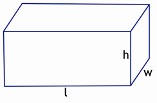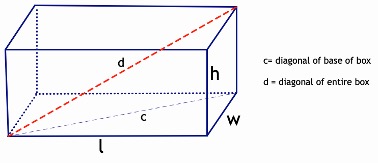Properties of a box:
Its surface area and volume, and the length of its diagonal

This unit has two parts:
Each student should bring an empty cereal box (or some other box) to work on. (The length, width, and height of the box should all be different.) A ruler and a calculator (we used a TI-108) are also needed. The tasks are to find the surface area and volume of the box, and the diagonal of the box. Make a data sheet with your answers and how you got them laid out! Be careful about units: inches, square inches, and cubic inches. Part 1a. Formula for the area of the surface (a) If l, w, and h are the length, width, and height of a box, its surface area is given by surface area = 2*(l*w + l*h + w*h). (Do you see it?) (b) Measurements Measurements are made in inches and sixteenths of an inch, but they are recorded as decimals. 1/8 inch = .125 inch, ¼ inch = .25 inch, 3/8 inch = .375 inch, ½ inch = .5 inch, and so on. Example: length l = 8.375 inches width w = 6.125 inches height = 2.25 inches (c) How to enter these measurements into a TI-108 calculator to get the surface area: 8.375*6.125 M+ 51.29… 8.375*2.25 M+ 18.84… 6.125*2.25 M+ 13.78… MRC * 2 = 167.84… square inches We round this to 168 square inches (more or less) Part 1b. We can also find the volume of the box: volume = l*w*h = 8.375*6.125*2.25 = 115.4… cubic inches If this were a hands-on unit, we would paper the box with square inch paper and fill the box with cubic inch blocks to see whether our computations are confirmed. Part 2. Finding the length of the diagonal of a box: For this unit it is revealing to have a stick or dowel (even a chopstick if it’s long enough) to insert into your box along its internal diagonal (red in the drawing below), after you get your mathematical answer, so you can check how close the mathematical answer is to the length that you measure with a ruler. 
We want to know the length of the diagonal d of the box, shown in red on the diagram. We can first compute the diagonal of the base of the box whose length l and width w are given. Let's call this diagonal c. c = √ (l2 + w2) (the Pythagorean theorem!) Notice that c is the leg of a new right triangle whose other leg is the height h of the box, and whose diagonal d is the diagonal of the box. (Do you see it?) For this right triangle, we know d = √(c2 + h2) But since c = √ (l2 + w2), we know, again using the Pythagorean theorem, that c2 = l2 + w2, so d = √( l2 + w2 + h2) And we have found how to get the length of the diagonal of a box with dimensions l, w, and h! In our example above, length l = 8.375 inches width w = 6.125 inches height = 2.25 inches c = √ (l2 + w2), and c2 = l2 + w2 For our TI-108 calculator, we enter 8.375 * M+ 70.14… this is l2 6.125 * M+ 37.51… this adds in w2 MRC 107.65… this is c2, the length of the diagonal of the base of the box We continue: 2.25* M+ 5.0625… we add in h2 MRC √ 10.61… inches—this is the length of the diagonal of the whole box (red in the diagram)! (We could round it to 10 ½ inches.) Now measure the length of the part of the dowel that is inside the box. Is it about 10 ½ inches? Lesson Index |